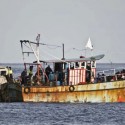Asylum seekers have for over a decade now been a frequently covered issue in the Australian media. The ‘Tampa’ affair of August 2001 was a significant historical catalyst for today’s legal and policy framework under which asylum seekers are dealt with in Australia. The Norwegian ship, M.V. Tampa, at the request of Australian authorities, rescued 433 asylum seekers from a vessel in distress. The original intentions of the ship’s captain, Arne Rinnan, were to continue on its course to Singapore. However, the intended course was altered after pressure from the rescued asylum seekers who demanded to be taken to Australia, with some even threatening suicide.
Captain Rinnan was then denied entry clearance to Australian waters. As the situation aboard got out of hand, he declared a state of emergency and decided to continue toward Christmas Island. He asked for assistance and medical supplies from Australian authorities due to concerns for the well-being of those rescued. This was particularly due to the lack of food, safety, and sanitary facilities for the large number of people on board (the crew originally numbered 27).

Those rescued sought to claim asylum in Australia; the then Liberal Howard Government was adamant that none of the 433 asylum seekers on board the Tampa would ever be permitted onto Australian soil. The government represented to the public that the asylum seekers were a threat to Australian sovereignty that needed to be met; SAS commandos were ordered to board and control the situation. A tough border protection stance was purported to be required to respond to this crisis. Eventually the asylum seekers were taken by the Australian Navy to the small island nation of Nauru.
It was here that infamous ‘Pacific Solution’ deterrence policy was born, in total diverting 1637 asylum seekers for processing to detention facilities in Nauru and Papua New Guinea (PNG) over five years. This was despite the fact that there were already detention facilities in Australia in 2001. However, the Pacific Solution was abandoned in 2007 after a change of government. Nevertheless, the current system in place in Australia still retains a policy of mandatory and indefinite detention for all who are not citizens and do not have visas.
What is crucial to understanding the great ethical dilemma Australia now finds itself in is the definition of both an ‘asylum seeker’ and a ‘refugee’. For the sake of brevity, an ‘asylum seeker’ is a person who has claimed to need protection (that is, claimed that they are a refugee) but has not yet had their application processed. A ‘refugee’ is a person who has been assessed and determined by either a state or the United Nations High Commission for Refugees (UNHCR) as requiring protection under the 1951 Refugee Convention.
It has become clear over the past decade that although immigration detention may be justifiable on a case-by-case basis, a blanket policy of indefinite immigration detention results in immense and needless moral, psychological, and financial costs for all stakeholders involved. Now that now offshore detention of asylum seekers is effectively indefinite, the already immense costs of such a policy can only increase.
Claims that consider offshore processing or mandatory detention as a ‘deterrent’ to future possible asylum seekers are not supported by any evidence. Hence, such claims constitute no more than an unsupported assertion.


























